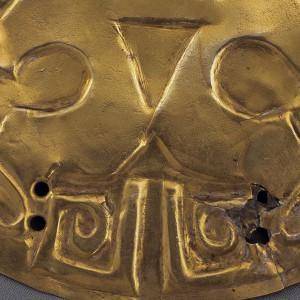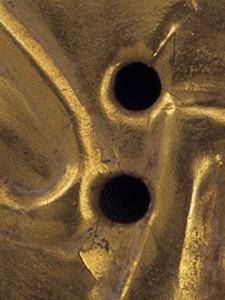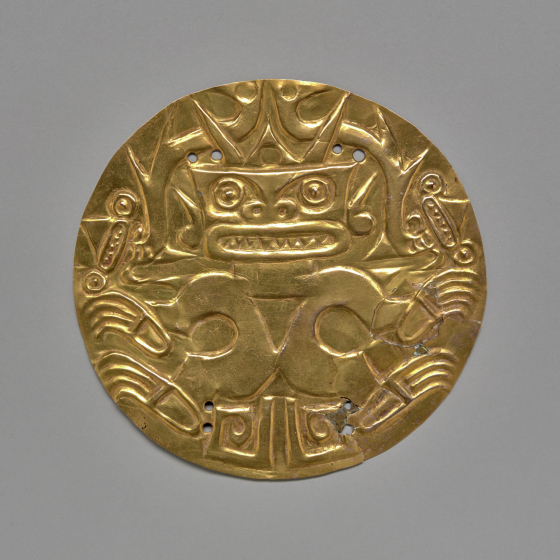Students will examine the artistic characteristics of the Plaque, locate Panama on a map of the world, and compare and contrast the Plaque and the civilization/culture that created it with another art object and its associated civilization/culture.
Students will be able to:
- examine the artistic characteristics of the Plaque;
- locate Panama on a map of the world; and
- compare and contrast the Plaque and the civilization/culture that created it with another art object of similar material or purpose and its associated civilization/culture.
Lesson
- Warm-up: Display or pass out copies of the Plaque and invite students to look carefully and share what they observe. What do they notice? What material was used to make the Plaque? What shapes appear on the Plaque? How would they describe the figure’s expression? What adjectives would they use to describe the figure? How do they think the artist created the Plaque? What purpose or function might the Plaque have served?
- Share with students that the Plaque was created in Panama about A.D. 450–900. Have students locatePanama on a world map. Share some quick facts aboutPanama (e.g., geography, climate, languages, natural resources, government, history) by distributing or displaying information from appropriate websites such as The World Factbook.
- Invite the students to compare this art object with another on Creativity Resource. You might want to have the students compare the Plaque with another object made of the same material (e.g., the Grip Enhancers (Menuki) from Japan), or with another object that was used for the same purpose of burial with the dead (e.g., the Mummy Case from ancient Egypt or the wooden Horse from the Han dynasty).
- Ask students to reflect on and discuss the following questions: How are these art objects similar to and different from one another? What kind of materials and processes were used to create each art object? For what purpose(s) was each art object created? Where was each object made? During what time period was each object made?
- Encourage students to create a T-chart or write a short essay comparing and contrasting the two art objects and the cultures or civilizations that created them. When students are finished, have them share their ideas aloud and/or display their pieces in a prominent place in the classroom.
Materials
- Piece of lined or unlined paper for each student
- Pens, pencils, or colored markers
- Map of the world, visible to all students in the classroom
- Computer with Internet access to appropriate websites, like The World Factbook
- Copies of About the Art sheet on the Panamanian Plaque (found at the end of the lesson plan) or student access to this part of Creativity Resource online
- One color copy of the plaque for every four students, or the ability to project the image onto a wall or screen
Standards
- Social Studies
- Critical Thinking & Reasoning
- Information Literacy
- Invention
- Self-Direction
Breastplate with Supernatural Crocodile
Although we don’t know who created this piece, we do know about the artist’s process. This plaque was made out of a gold and copper alloy, or metallic mixture. Mixing gold with copper lends strength to the piece, but the artist would have been careful not to add too much copper because it can lead to corrosion. The artist first heated the gold alloy and then hammered it using a stone tool, repeating the process until the desired thickness was achieved. He then cut out a circular disc and embossed the design onto the surface, adding additional detailing with a chisel. To emboss the design, the artist laid the disc on a firm but somewhat yielding surface and pushed the metal out from the back.
This gold plaque was reportedly found at Parita, on the Azuero Peninsula of central Panama. It closely resembles breast ornaments found in graves at Sitio Conte, an archaeological site in central Panama. In addition to gold plaques such as this, the most powerful and important individuals buried at the site were surrounded with extraordinarily lavish offerings, including sacrificed attendants, polychrome pottery, whale and shark teeth, and other gold ornaments.
Plaques like this, sometimes stacked on top of one another, have been found covering the chests of high status individuals in archaeological excavations of tombs. Hammered into this flat, gold plaque is a figure in an upright human-like pose. This creature has sometimes been called the “Crocodile God.” It has long, reptilian claws, a split tail, staring eyes, flaring nostrils, and a wide mouth with sharp, interlocking teeth. The ears are pointed and horn-like elements rise from the head. Above the head are two fish-like animals with spiky bodies. Powerful individuals in ancient society probably identified themselves with this fierce looking supernatural being. Recent research suggests that the figure may represent an iguana with supernatural attributes.
Details

Head
The large rectangular head has a mask-like face with circular eyes and a flattened nose. The grinning or grimacing mouth has prominent triangular interlocking teeth. On the side of the head are upward-flowing ear ornaments. Antler-like appendages protrude from the top of the head. Two sharks are entwined in the antler projections on either side of the head.

Body
The body is androgynous and unclothed. Both the hands and feet have claws, five on the hands and four on the feet.

Tail
At the bottom of the figure is a split, curved tail that spirals outward in opposite directions. In the center of the figure is a triangular depression.

Holes
Four pairs of holes were pierced through the finished disk so that it could be held firmly in place on the clothing or costume.
Funding for object education resources provided by a grant from the Morgridge Family Foundation. Additional funding provided by the William Randolph Hearst Endowment for Education Programs, and Xcel Energy Foundation. We thank our colleagues at the University of Denver Morgridge College of Education.
The images on this page are intended for classroom use only and may not be reproduced for other reasons without the permission of the Denver Art Museum. This object may not currently be on display at the museum.







